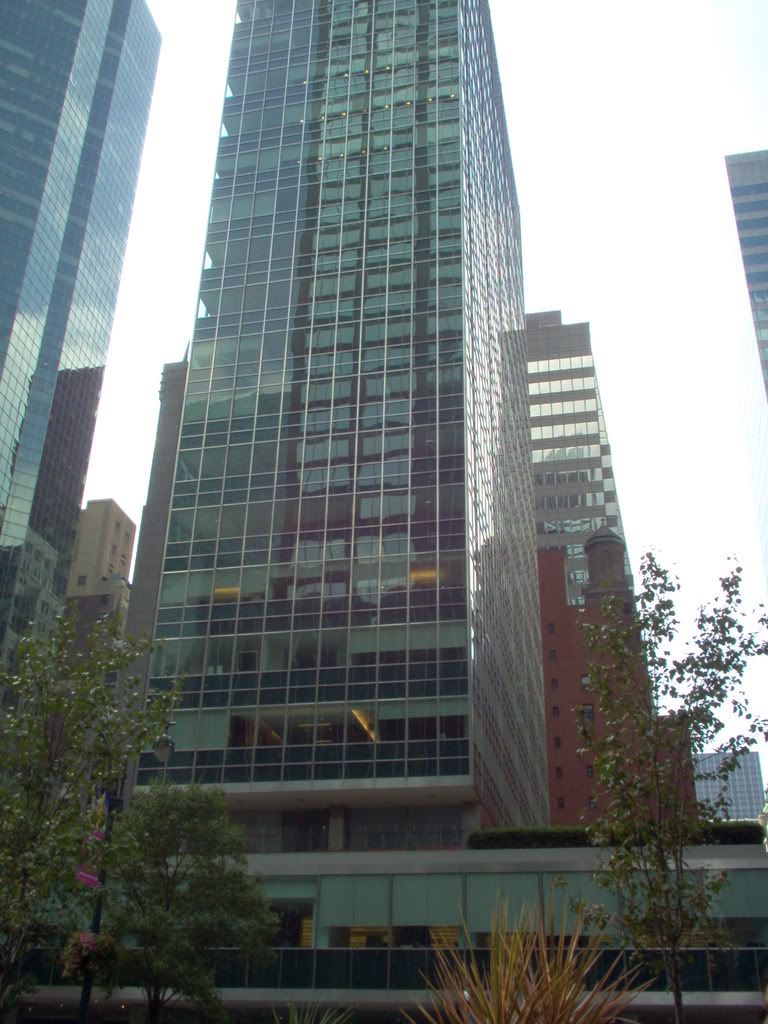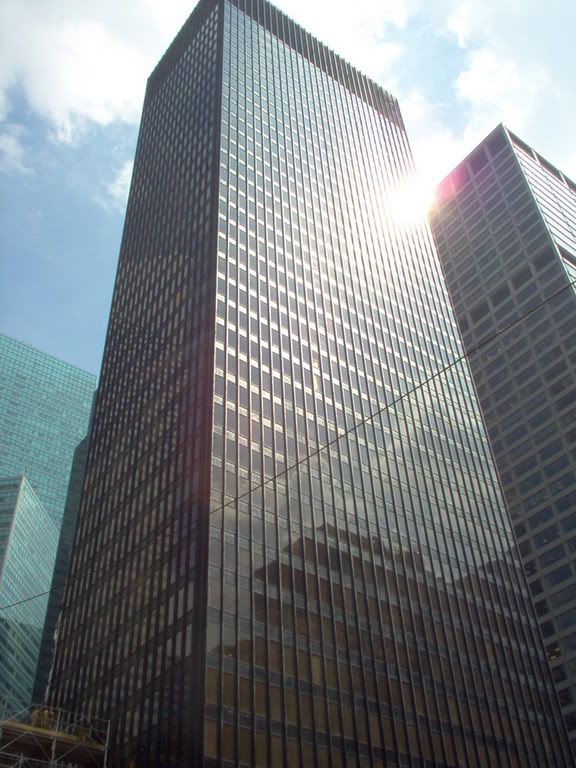It took me years to wake up from the dream and realize, only after living here, that Manhattan is a nightmare, speaking buildings. The science and art of erecting skyscrapers has not graced our glorious city. Or maybe the science has, but certainly not the art. What we have in the streets and skies of our mighty city is a depressing catalogue of boring, uninventive corporate architecture at its most dreary and drab. The sterility of Manhattan skyscrapers is only comparable to the similarly dismal, corporate-communist-style Soviet official buildings. Where New York is a skinny vertical glass box, Moscow is a bulky horizontal stone box. Both share a brutal lack of creativity.
So, what happened in New York City after 1945? The first half of the bloody twentieth century saw many fine tall buildings in Manhattan.
What was the blessing and inception of modern (and postmodern) architecture was also its curse: the glass box, light curtains of post-war transparency. The so-called “International Style” or “Modern Movement” that dominated architecture was a very American movement, created actually the term by Philip Johnson and Henry Hitchcock in a book and exhibition at MoMA 1932, but it had (as almost everything in America) European roots. The “Modern Architecture” was, in fact, an American variant and implant of the German Bauhaus architecture, spread in the States when many of the pioneers fled the Nazis and settled in the East Coast: Walter Gropius, Marcel Breuer, Mies van der Rohe, Le Corbusier, Josep Lluis Sert.
The expansion of the glass-and-steel style of the Modern Movement boomed in America after the II World War. Ever since Gordon Bunshaft from the architectural firm Skidmore, Owings & Merrill designed Lever House (1952) in Park Avenue, New York City, nothing was to be the same ever again in the American city and landscape. Suddenly, the country said goodbye to the stone-and-brick architecture of yore, and welcomed (voluntarily or forcedly) the new style, all lightness and functionality.

The inventiveness, creativity and beauty shown in first-half-of-the-century New York tall buildings like the Flatiron, Empire State, Woolworth, Chrysler or Louis Sullivan’s Bayard-Condict were gone, substituted by conservative, non-charismatic containers of offices and cubicles for the American corporation post-1950’s. Quantity surpassed quality in terms of architectural output. Whereas in the 1930’s Johnson & Johnson commissioned Frank Lloyd Wright to design a wonderfully innovative corporate headquarters in Racine, Wisconsin, in the 1960’s Chase Manhattan Bank was calling SOM to build a… glass-box skyscraper. Tall, very tall- dead.
Manhattan Island was being filled, overnight, with soaring black glass boxes signed “SOM” and resembling a bad copy of Mies’ Seagram Building.

What happened? SOM and its monstrously harming corporate machines in every city of America, Asia and beyond are not what Mies envisioned as the glass-and-steel construction for a new era. The bastard sons of Mies van der Rohe and Walter Gropius are a misleading reality against modern architecture. Or are they?
As often, the originators of the American glass box were distinctive, distinguished, elegant. You will not or should not confuse a Mies van der Rohe or Gordon Bunshaft with a SOM-type post-sixties corporate skyscraper. Along Park Avenue, where glass-and-hollowness office buildings reign, Lever House and Seagram Building stand proudly, surrounded by dastard SOM’s. They’re the real thing and shine.
But even the fathers of corporate-architecture-before-boredom pendulated between grace and brutality: Mies could create a floating marvel of pure light in the Farnsworth House or depressing apartments caged in steel boxes in Detroit and Newark; Marcel Breuer achieved impossibly high levels of linear beauty and harmony in his Minnesota and Michigan churches, but built ugly corporate steel boxes in the Pirelli and IBM Buildings. Walter Gropius never had much for beauty or grace, but his Bauhaus at Dessau building or his own house in Massachusetts are a counterpoint for that most-hated building in New York, the one your eye can’t avoid, the ex-Pan Am now Metlife Building.
The International Style is as confounding as these extreme polarities of the masters. If New York is today an island of bad, brutal architecture is not only because the disciples of the Modern Fathers took a wrong lesson, but also because the very fathers were bad and brutal themselves sometimes. Let’s not forget that Walter Gropius was actually proud of his Pan Am thing, and that he proposed, as Head of the Harvard School of Architecture, bulldozing entire parts of the city of Boston to replace them with his vision of modern architecture.
And Mies tried really hard to ingratiate himself with the Nazis. Goebbels did like him, and he would have being the official grand architect of the Third Reich, if only Hitler wouldn't have come across Albert Speer.
It is seemingly fitting then, as somebody has pointed out, that the “everything’s valid coming from the master” attitude is responsible to some or many of the disastrous architecture in America and elsewhere after the fifties. Should we accept the lame UN Headquarters because it’s a Le Corbusier creature? Should we hail the bleak and cheap Lafayette Apartments in Detroit and the Colonnade in Newark for being a Mies van der Rohe creation? Should we preserve the Pirelli Building in New Haven as a Marcel Breuer masterpiece, or tear it down for being an ugly piece of bad architecture?
At least (almost) nobody respects the Pan Am…
Once accepted the calamities of Masters Mies, Breuer & Co. as masterpieces, the SOM epidemic is just a predictable result of that laxness.
The deceiving aspect and reality of the Modern Movement in Architecture is affecting its conservation. There is a “battle” nowadays for the preservation of everything modern, whether hotels, diners, federal buildings, banks, churches and any other contribution to the gloomy architecture of the American fifties and sixties. How far are we going, with organizations trying to save even SOM offices? Is the glass box the new colonial? The “in” thing to save. The rage to save our recent past must be a very American thing. But- shouldn’t we be more discerning?
As if trying to make up for the wide destruction allowed in the recent past (Penn Station will be forever mourned), America wants to save now everything and anything from that recent past. Even if that means fighting for the likes of One Penn Plaza.
In a city living in a never-ending process of destruction and reconstruction, I (we) would like to see so many fifties and sixties things torn down to leave room for the new architecture.
Who is to blame, that in a small stretch of land with hundreds of skyscrapers, only a very few are masterpieces?
Meanwhile, it looks like if the cityscape of Manhattan-New York could be in the wake of a promising change. A new generation of Europeans (not Germans, thankfully?) arrives to the capital of the world to transform, once again, our architectonically lower-achieving city, now for the new millenium. The ingenuity of Norman Foster, Renzo Piano, Christian de Portzamparc, Jean Nouvel and the Americans Richard Meier and Frank Gehry should be that long-awaited slap in the structure of the corporate glass box.
At the same time, though, the feverish construction of high-rise apartment and office buildings profiting the real-estate frenzy is granted to the conservative firms of Fox&Fowle, Costas Kondylis, Cesar Pelli, Gwathmey Siegel or Kohn Pedersen Fox, among the most renowned and unappealing constructors of postmodern glass coffins.
And the most symbolic, decisive and important project of the new century, the Freedom Tower on the World Trade Center site, will be built by SOM.
What future, then?
Just what we have: an island of bad architecture with a couple of remarkable buildings.
So much for this, Mies!

